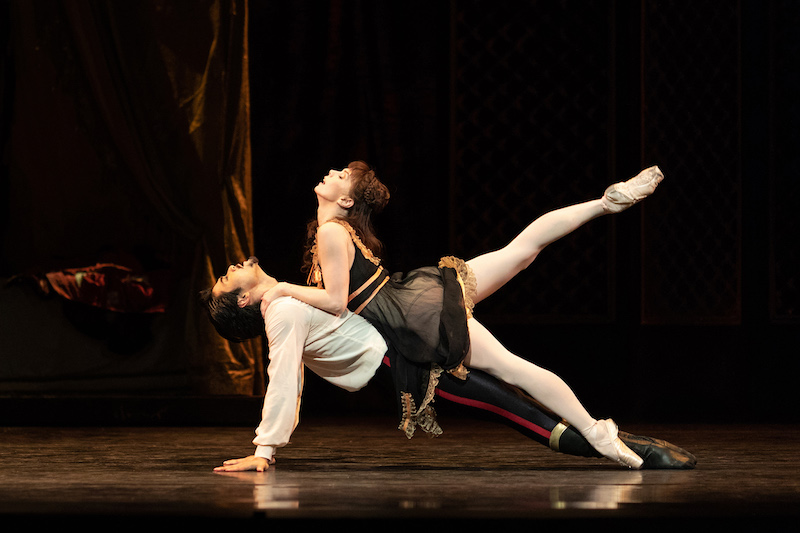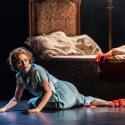Although the loss of its 96-year-old royal patron can hardly have come as a surprise, Covent Garden has been slow to register it. The gold-embroidered ERs on those luscious red velvet stage curtains remain in place, and when Wednesday night’s audience was invited to stand for the playing of the National Anthem, the uninvited vocal response was heard to “send her victorious”. Old habits die hard.
Perhaps those same loyal subjects were also oblivious to the oddity of the Royal Ballet’s dedication of the opening performance of its new season to the late Queen. Kenneth MacMillan’s Mayerling is about a royal family in crisis – personal, political, existential – ending in a desperate official cover-up of a murder-suicide. And if the troubles of the Habsburg dynasty in 1889 share only a few features with those of the Windsors, they also make them seem trivial. The Habsburgs were in a downward spiral that proved terminal.
That said, there could be no better choice of ballet to mark the 30th anniversary of the death of its choreographer, who collapsed backstage aged 63 during a performance of this work. To a three-act story-ballet format that had till then been largely the realm of myths and majesty, MacMillan applied the values of modern theatre, harnessing the expressive qualities of ballet to extreme psychological states. And in this tale of family dysfunction, hypocrisy, sexual depravity and morphine addiction – which as far as one can tell is no exaggeration of the known facts – those psychological states are off the dial.
Just as in MacMillan’s four other full-evening ballets – which include the more box-office friendly Romeo and Juliet and Manon – Mayerling starts by presenting an apparently functioning haut monde before pulling at the threads that will cause it to unravel. The costume department has a field day kitting out the aristocratic guests at the opening scene’s grand wedding party following the union of Crown Prince Rudolf of Austria-Hungary to a 16-year-old Belgian princess. That this is purely a political match is clear when Rudolf flirts outrageously with her sister, partnering her in preference to his timid new wife in a very public waltz, an act which virtually amounts to a declaration of war. While the causes and effects of Rudolf’s increasingly disturbed behaviour are many and complex, the choreographer guides us through them with great narrative skill. Perhaps uniquely, this is a three-act story ballet with no padding. Every scene – whether in Rudolf’s bedroom where he terrifies his young bride by holding a pistol to her head, or in the Vienna brothel where he fraternises with Hungarian seditionaries, or at an intimate royal soirée rife with adulterous liaisons – is densely layered with telling detail. More significant still, given that this is ballet, is that you are hard pressed to distinguish the theatrical story-telling – what you might call pure acting – from the narrative of the steps. The blend is seamless, and utterly absorbing and convincing.
While the causes and effects of Rudolf’s increasingly disturbed behaviour are many and complex, the choreographer guides us through them with great narrative skill. Perhaps uniquely, this is a three-act story ballet with no padding. Every scene – whether in Rudolf’s bedroom where he terrifies his young bride by holding a pistol to her head, or in the Vienna brothel where he fraternises with Hungarian seditionaries, or at an intimate royal soirée rife with adulterous liaisons – is densely layered with telling detail. More significant still, given that this is ballet, is that you are hard pressed to distinguish the theatrical story-telling – what you might call pure acting – from the narrative of the steps. The blend is seamless, and utterly absorbing and convincing.
The opening night cast sprang no surprises, being largely a duplicate of the first cast in the 2018 revival. Notably, though, as Rudolf, Ryoichi Hirano (main picture, and above with Natalia Osipova) has deepened his interpretation, and he now properly lets rip in the final scenes. In this he is hugely enabled by Natalia Osipova’s frightening self-abandon as the infatuated teenager Mary Vetsera, who joins him in his all-night binges of sex and drugs and firearm handling. We don’t need to know whether she’s really into guns and skulls and suicide pacts or doing it just to please him, but she’s a victim either way.
The real driver of events is Countess Larisch, a discarded lover of Rudolf’s and family friend of Mary, who takes pleasure in controlling who he sleeps with if it can’t be her. Laura Morera gives this social-climbing schemer a venal energy that gives wings to every scene. Under the pretence of taking the 17-year-old Mary under her wing, she pimps her, organising secret visits to the Crown Prince’s private rooms, and ultimately to Mayerling, the royal hunting lodge hidden deep in the Vienna woods. Grim parallels with Ghislaine Maxwell and Jeffrey Epstein are unavoidable.
Standout cameos abound in this drama. Itziar Mendizabal is marvellously chilly as Rudolf’s mother, the Empress Elisabeth, whose life has been one long disappointment. This is brought keenly into focus when she presents her husband, the stuffy Emperor Franz Josef, with a portrait of his lover as a birthday gift. In her single scene alone with Rudolf, she repels his pleas for motherly attention, pretending to be absorbed in a fashion magazine. Francesca Hayward meanwhile makes an unusually wan young bride, mutely terrorised by Rudolf’s mawkish bedroom antics and his flinging her about like a rag doll. There are times in this ballet when, for all the choreographic ingenuity, the violence of the pas de deux makes one queasy, and this particular bout of cruelty – child abuse by today’s standards – verges on gratuitous.
Light moments are few and far between, but there are some. Luca Acri is sharply entertaining as Rudolf’s personal cab driver Bratfisch, distracting him with cabaret-style hi-jinks when the going gets heavy. And Marianela Nuñez is serenely benign as his regular mistress Mitzi Caspar, immaculate in a beautiful pure-dance setting of Franz Lizst’s Mephisto Waltz, to which, counterintuitively, she and others trot joyfully like head-tossing fairground ponies, not devilish or frenzied at all.
Mayerling is ultimately a company showcase, demanding talent in breadth and depth, not least in the music department. My companion for the evening wondered how the story managed to maintain such dramatic tension, given that everyone knows how it ends. Liszt’s music, in wide-ranging extracts selected and orchestrated with great dramatic flair by the late John Lanchbery, should take at least half the credit. Not always when music written for another purpose is commandeered for ballet does it find such a snug fit. Here, one could believe it composed to order. Every mood and situation is catered for, from royal pomp to bridal night trepidation to morphine-dulled madness and even a police raid. Kudos to Koen Kessels too for the gamut of textures he drew from the House orchestra. An unforgettable evening, then, on every front.














Add comment